What is the Philips Screeno HDP1590TV?
If you like the idea of having a 100-inch TV but don’t want the inconvenience of a gigantic black box in your living room you need to check out something like the Philips Screeneo HDP1590TV. It’s an ultra short-throw projector that can create a huge projected image even when it’s just a few centimeters away from a wall.
The Philips Screeneo gets rid of much of the inconvenience of fitting a projector into a normal-size living room, and is extremely flexible in several respects. However, image quality limitations mean it is not one true home cinema fans should consider, especially given it costs £1500.
READ MORE: Projectors Reviews
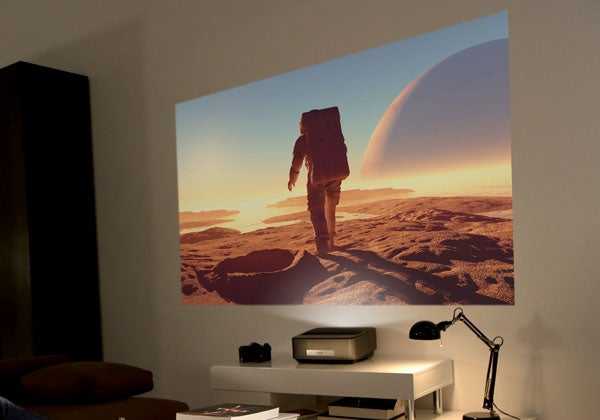
Feeding frenzy
The Philips Screeneo HDP1590 Smart LED projector is not short of a port or two either. It’s ready to display pretty much anything that can be output through a cable: there are three HDMI ports, VGA and Composite available to take on all kinds of sources. Our do-it-all solution was the trusty PlayStation 3.
The Screeneo also has built-in 5GHz Wi-Fi for DLNA (Digital Living Network Alliance) playback — such as dipping into an external, networked drive via Plex — in addition to two USB ports and an SD slot for streaming files. That’s the idea anyway.
But we hit a snag with our first review unit. Even over a fast router connection the picture from a networked drive was really stuttery. We could bypass this issue as we were were using our PlayStation 3 console to do all the hard work — and via HDMI into the Philips playback was absolutely perfect; smooth for DVD, Blu-ray, gaming and files via the PS3’s USB port.
Perhaps we were asking the buffer to handle too much, we thought. We explored different file sizes, formats and resolutions but all had the same issue. The penny dropped: the software wasn’t up to scratch.
We tried firmware updates via USB card but Screeneo didn’t like it. Philips sent us a pre-loaded SD card but, again, no luck. So we had the unit swapped out for a second review sample. But not all our troubles were solved: the quality was there but every 15 seconds or so playback via DLNA stuttered for a millisecond — like streaming a movie before high speed internet existed. Using the same process and connection our Samsung Smart TV didn’t suffer such playback issues when viewing the same content.
There is also a built-in TV tuner which means instant channels after plugging in an aerial cable. The only issue here is those channels come through in standard definition only and compression is a problem, just as SD channels on telly can be. And when viewing at a huge scale that really makes things look granular — trying to watch the football was like watching a moving Van Gogh painting.
Bluetooth is also on board to allow streaming of music from a smartphone or tablet. This is something that might sound gimmicky, but as the Screeneo has a 26-watt, subwoofer-backed Dolby Digital 2.1 sound system built in it sounds great. Playback is limited to MP3 and WAV files in this mode at the moment, but if you mirror your device over Wi-Fi you can use streaming services like Spotify no problems.
Design
Position it 10cm away from the wall and you’ll get a 50in picture; move it to 44cm away and the image size grows to 100in. There aren’t any adjustments as far as levelling goes and the focus control is rather vague in action, but overall it’s fairly fuss free to get going.
Of course, using a dedicated screen will give the best results. But this Philips is happy projecting straight onto a wall. It even offers a certain amount of compensation for the wall colour through the well laid-out set-up menus.
Even with everything optimised, this projector’s appeal doesn’t rely on its picture making ability – a good thing too, as it’s decent at best. The Screeneo is an HD-ready design with a resolution of 1280 x 800. This means it has to upscale standard definition material and downscale Full HD.
All this processing takes a toll, as a comparison with Epson’s similarly priced EH-TW6100 shows. There’s a clear shortfall in terms of detail and naturalness. Black levels are deep, but lack insight, while the colours are overly rich and could be subtler.
But, let’s not be too harsh here. The Screeneo’s main purpose is to combine a large image with portability – something that traditional projectors like the Epson aren’t designed for.
Карманный проектор с модулем WiFi на Android
Вам больше не нужно подключать смартфон или ноутбук, чтобы получить доступ к Интернету. Просто включите WiFi-соединение и просматривайте веб-страницы с помощью браузера проектора PicoPix 3610 или 3614. Если доступ к сети WiFi отсутствует, используйте проектор PPX3614 или PPX3610 в качестве персональной точки доступа: создайте сеть для подключения устройств с поддержкой стандарта DLNA и передавайте контент на большой экран. Оцените великолепное качество изображения и удобство беспроводного подключения по стандартам Wi-Fi и DLNA.
|
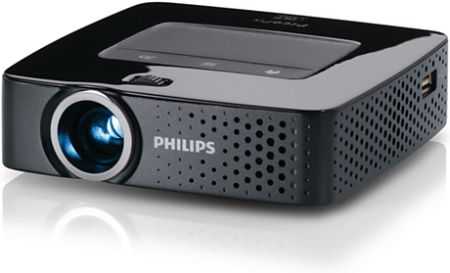 |
Стоит ли говорить, что сочетание всех неоспоримых преимуществ портативных проекторов Philips сделало их вторым по желанности подарком для мужчины по версии телеканала НТВ!
Используйте все возможности функциональных проекторов Philips для развлечений и решения деловых задач. Где бы Вы ни находились — дома, в дороге и в офисе наслаждайтесь просмотром изображения превосходного качества.
Performance
Judged on its own terms this Philips delivers perfectly enjoyable images. Play the Blu-ray of Thor: The Dark World and you’re in for a fair bit of fun.
Colours may be over cooked, but the projector’s vivid approach is pretty likeable and never goes far enough to jar. We’re pleased with the punchy white levels and overall contrast is strong. The claimed contrast ratio is 100,000: 1.
Move to 3D in the form of Gravity and the Philips piles on the plus points. Its active 3D image is surprisingly stable – helped by the intelligent way this film implements the technology.
The projector’s ability to combine dark and bright elements in a single frame come to the fore with the deep space scenes where the multitude of stars stand out brightly from the black background. The Philips is impressive with 3D. It’s just a shame there’s only one pair of glasses supplied in the box.
Admittedly it doesn’t deliver the subtlety and sharpness you’d get from a Full HD rival such as the BenQ W1080ST+, but the rich colour balance, fine contrast and stable image remain. Skin tones are decently handled and, on the whole, the Philips remains an entertaining watch.
You can watch TV too. The Screeneo has a built-in standard-def digital tuner, and it does a pretty good job. Picture noise is kept at a relatively low level and the character of the image is consistent with the projector’s performance elsewhere. Fast moving objects are dealt with competently.
Usually, we find the built-in speakers in projectors poor. Not in this case. While no substitute for a dedicated sound system, this projector sounds surprisingly balanced.
It certainly performs way better than most TVs, even good ones. A rated total power of 26 watts doesn’t sound like much, but it’s enough to give the sonic presentation a fair amount of authority and scale.
It’s a full, relatively smooth balance with little of the harshness and thinness we normally come across. Delve into the relatively intuitive menus and you’ll find adjustments to expand the sound and alter the bass balance. It’s worth playing around with these as they helped the sound considerably in our largish test room.
At a push, the sound quality is just about good enough to use the projector as a (background) music system. It’s the first time we’ve ever written that about a projector.
Big screen button bashing
Watching films on a 100-inch display is a really immersive experience. But when it comes to gaming this scale takes it to another level. You feel like you’re actually in the game — that’s the best way to describe it. We were swinging about Gotham City as Batman in Arkham Origins and really forgot about the wider world. And isn’t that what big displays are all about?
The dark landscapes and fast refresh rates of a game like this tested the projector and left it chugging along quite capably. We say chugging, it’s actually far quieter than the PlayStation 3 that was handling the game.
Gaming is also a great reason to have the portability of this projector. Popping round to a mate’s for a massive multiplayer session is easy, presuming they have a clear wall available.
Writing by Luke Edwards.
Проводное или беспроводное подключение
Во время просмотра фотографий на смартфоне или планшетном ПК подключитесь по беспроводной сети к Screeneo, который мгновенно отобразит экран устройства. Все, что бы вы ни делали на своем портативном устройстве, будет проецироваться по беспроводной сети с помощью Miracast.
Используйте Screeneo как мультимедийный центр. Функции Bluetooth и DLNA (Digital Living Network Alliance) позволяют передавать музыку, видео и фотографии со смартфона или планшетного ПК на Screeneo.
Если вы предпочитаете физические носители данных, то вы можете подключить Screeneo по кабелю HDMI, вставить SD-карту в устройство чтения карт памяти, подключить флэш-накопитель USB или антенну.
Забудьте о проекторах или ТВ! То, что вам нужно, – это Screeneo!
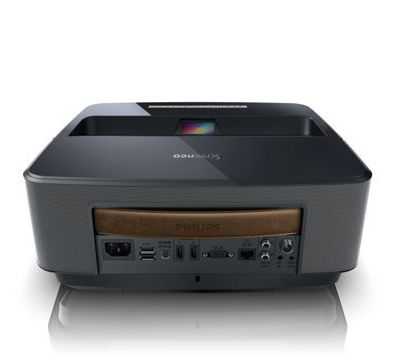
Project the third dimension
The third dimension is a love/hate thing depending on who you ask. The Screeneo can cater for 3D and it’s easily when sourced from, say, a 3D Blu-ray. The active shutter glasses pair automatically and the refresh rate is good so it’s easy to forget you’re watching 3D (unless you’re one of those that can’t stand it).
But when it comes to the 2D-to-3D processing function we wouldn’t recommend it for anyone with a weak stomach. With a Netflix feed we attempted to use this mode watching the 2D version of Captain America, but in 3D. After a few minutes, where sometimes it’s possible to get used to the feed, we gave up. The depth was a blur and the shifting between scenes, which were dark through the glasses, left us feeling dizzy.
Product description
Depth:28.7 cm, Width:33.9 cm, Height:14.8 cm, Max Operating Temperature:35 °C, Min Operating Temperature:5 °C, Humidity Range Operating:15 — 85%, Interfaces:1 x VGA ¦ 1 x composite video input ¦ 1 x headphones — mini-phone stereo 3.5 mm ¦ 1 x audio line-out ¦ 3 x USB — 4 PIN USB Type A ¦ 3 x HDMI input — 19 pin HDMI Type A, Expansion Slots:1 x SD Memory Card, Focus Type:Manual, Cables Included:1 x HDMI cable, Included Accessories:Carrying case, 2 x AA batteries, remote control, Nominal Voltage:AC 120/230 V ( 50/60 Hz ), Resolution:WXGA — WXGA (1280 x 800), Native Aspect Ratio:4:3, Bulb type:RGB LED array, Bulb life cycle:Up to 30000 hour(s), Contrast Ratio:100000:1, Projection Distance:10 cm — 44 cm, Image Size:127 cm — 254 cm, Features:JPEG photo playback, MP3 playback, 16:9 aspect ratio support, BMP photo playback, built-in 4GB flash memory, DLNA support, WAV playback, PNG photo playback, Android 4.2, GIF photo playback, Type:Integrated, Sound Output Mode:Stereo, TV System:NTSC, SECAM, PAL, Video Interfaces:VGA, HDMI, composite video, Digital Video Format:MPEG-4, AVI, MOV, FLV, MKV, TS, Analogue video Signal:RGB, composite video, LAN and Wireless Image Transferring Protocols:IEEE 802.11b, IEEE 802.11g, IEEE 802.11n, Supported Memory Cards:SD Memory Card, Video Modes:480p, 720p, 1080i, 1080p, 480i, 576i, 576p, 720i
Product details
- Batteries
:
1 Product Specific batteries required. (included) - Is Discontinued By Manufacturer
:
No - Product Dimensions
:
33.9 x 28.7 x 14.8 cm; 5.3 Kilograms - Date First Available
:
28 Mar. 2014 - Manufacturer
:
KOMQI - ASIN
:
B00HNO8SJ6 - Item model number
:
HDP1590
Customer reviews:
/*
* Fix for UDP-1061. Average customer reviews has a small extra line on hover
* https://omni-grok.amazon.com/xref/src/appgroup/websiteTemplates/retail/SoftlinesDetailPageAssets/udp-intl-lock/src/legacy.css?indexName=WebsiteTemplates#40
*/
.noUnderline a:hover {
text-decoration: none;
}
2.8 out of 5 stars
4 ratings
P.when(‘A’, ‘ready’).execute(function(A) {
A.declarative(‘acrLink-click-metrics’, ‘click’, { «allowLinkDefault» : true }, function(event){
if(window.ue) {
ue.count(«acrLinkClickCount», (ue.count(«acrLinkClickCount») || 0) + 1);
}
});
});
P.when(‘A’, ‘cf’).execute(function(A) {
A.declarative(‘acrStarsLink-click-metrics’, ‘click’, { «allowLinkDefault» : true }, function(event){
if(window.ue) {
ue.count(«acrStarsLinkWithPopoverClickCount», (ue.count(«acrStarsLinkWithPopoverClickCount») || 0) + 1);
}
});
});
Карманный проектор с USB QuickLink
Если вы хотите передавать данные напрямую с камеры, смартфона или USB-накопителя, то карманный проектор с портом USBQuickLink — самый удобный и оптимальный вариант для всех устройств. Просто подключите разъемный соединитель USB и используйте USBQuickLink в качестве держателя. Покажите друзьям медиа- или веб-контент, отображаемый на экране ноутбука, например, видеоролики с YouTube и фотографии с вечеринки на экране с диагональю до 60 дюймов.
|
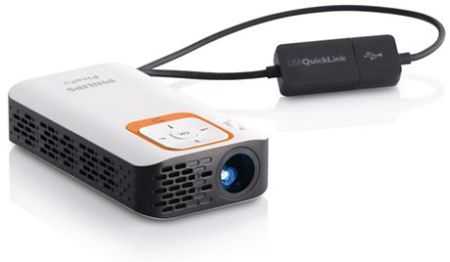 |
We like to move it, move it
The portability of the Philips Screeneo is one of its strongest selling points. One weekend we were due to test it at home when a last-minute trip came up, so rather than leaving it at home we took it along with us. It was easy to transport, as the 5kg unit comes in a shoulder carry bag with a spare pouch for cables, controller and 3D glasses. The Screeneo itself even has a brown leather strap for easy removal from the bag. Then all we had to do was find a nice large wall, plonk it down and plug it in.
At 10cms away from a wall you’ll get a 50-inch projection, increasing to 100-inch from just 44cm away. The distance from the wall is the only way to adjust picture size, meaning the projector will be sat in front of you, typically on the floor or a low-slung table. It was possible to get the display larger, but the brightness and clarity fall off, hence the given 100-inch limit.
If finding a large white wall is an issue then you can delve into the menu for a variety of wall colour corrections. So if there’s a blue wall the Screeneo will adapt the projected colours to work on that surface. It’s less bright in playback on darker walls but this is still a helpful feature if the only wall available isn’t white.
One of the reasons the Screeneo’s portability is so useful is that the projector can be used in addition to a TV, which is how we think it’s most likely to be used. TV for the day-to-day, Screeneo unveiled for special occasions, like a movie night or sports event. It really made watching Gravity at home a cinema-like experience for us, ignoring the maximum resolution limit. At home you won’t get stuck behind the world’s loudest popcorn eater either.
Longer, brighter, cooler
Using LED to project lowered our expectations of the Screenio before we powered it up. But once we were viewing a movie it was clear that the 100,000:1 contrast ratio was more than enough to throw a bright picture, even with the curtains open so long as the sunlight wasn’t too strong. Watching for a long period in daylight wasn’t really an option as everything looked washed out, so darkness is your friend.
Unlike traditional bulb-based projectors the Screeneo boasts a 30,000 hour life. A similarly priced Sony short-throw projector, for example, with a 3800:1 contrast ratio will need a new bulb after 3,000 hours on at high power, costing around £250 to replace.
The other issue we were worried about was the 1280 x 800 resolution. When our considerably smaller phone screens and TVs are pumping out 1920 x 1080 as standard these days, the Screeneo projector resolution sounds poor. But it’s not that bad. Even when set at the 100-inch display limit the picture is clear when converting a 1080p feed into the 720p capability of the projector. At first the manual focus, achieved by twisting a control dial repeatedly, was needed to clear up the image but once that was perfect the picture was of a high quality.
Of course if money is no object and space isn’t either then a higher-resolution projector is obviously going to deliver a far superior picture. Cinemas tend to project at 4K these days, so the Philips can’t claim to achieve that kind of jaw-dropping awesomeness. But it’s still awesome in its own way, largely on account of projected screen size.
Philips Screeneo HDP1590TV – Design and Features
As one of the first ultra-short projectors we’ve seen to be clearly marketed as a home entertainment gadget rather than a classroom tool, it’s good to see that the Philips Screeneo does not have a massive lens housing begging to be scratched. Instead the lens is hidden away.
From a quick glance it appears a bit more like an oversized iPod dock, with speaker grille sides and a silvery front panel that looks like a DVD tray. Appearances prove wholly deceptive.
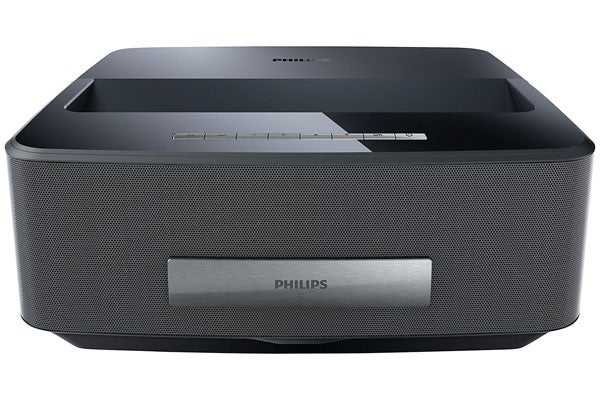
The iPod dock-style indent on the top is where the Screeneo outputs its images, and the silver front panel is actually just a cover for a bunch of additional ports. At 30cm wide it’s not pico-projector-portable, but it does at least look like it belongs in a lounge rather than a cinema. There’s a carry handle on its back too, making it a cinch to lug the Screeneo between houses – you also get a carry case for such eventualities. The Philips Screeneo is also quite ridiculously feature-packed. As well plugging into standard sources over HDMI, composite or VGA, you can play music through the thing over Bluetooth, and play movies, run apps and even games directly from the Screeneo.
Here’s where things get really interesting. The Philips Screeneo runs Android, with a top layer UI that makes it look like a fairly standard bit of home cinema kit – focusing on inputs and settings rather than anything else. It doesn’t have the Google Play app store installed, but with an SD card slot and USB port on the thing and full file system access, you can easily get a third-party app store installed.

While you wouldn’t want to use the included remote to play games, with inbuilt Wi-Fi, Bluetooth and 4GB internal memory, you could make this into a games console of sorts if you buy a separate Bluetooth controller. There is an awful lot of fun to be had with the Philips Screeneo.
Coming back down to normal home cinema territory a bit, the Screeneo also has an inbuilt standard-def Freeview TV tuner, support for playing back a bunch of file formats from USB devices, including MKV, and speakers. Integrated speakers in projectors are generally dreadful, but these ones aren’t too bad.
The Screeneo has a stereo pair of side-firing drivers plus a dedicated bass driver, powered by a 26W amp. You wouldn’t want to replace a 5.1 system with this setup, but they will do the job for an impromptu movie night, offering a nice even tone and a bit of bass warmth, if not depth. It’s on par with a half-decent portable Bluetooth speaker. What’s more, because the projector is short-throw, the sound is actually coming from close to the picture, rather than from behind as with a conventional projector.
If you’re a real sound fan, you can hook up some powered speakers over Bluetooth or the headphone output. There are also optical and phono audio outputs, but these don’t seem
quite as handy unless you’re planning on using the Screeneo as a source,
rather than just a projector.
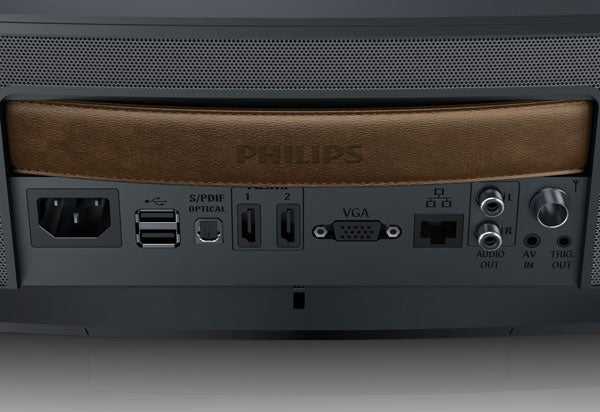
You can do an awful lot with the Screeneo, much as you have to be a bit of a geek to work out some of the most fun bits. That said, getting the basics working is no more difficult than the usual cable A in socket B affair you get with any home entertainment gear.
ROUND-UP: Best Projectors































